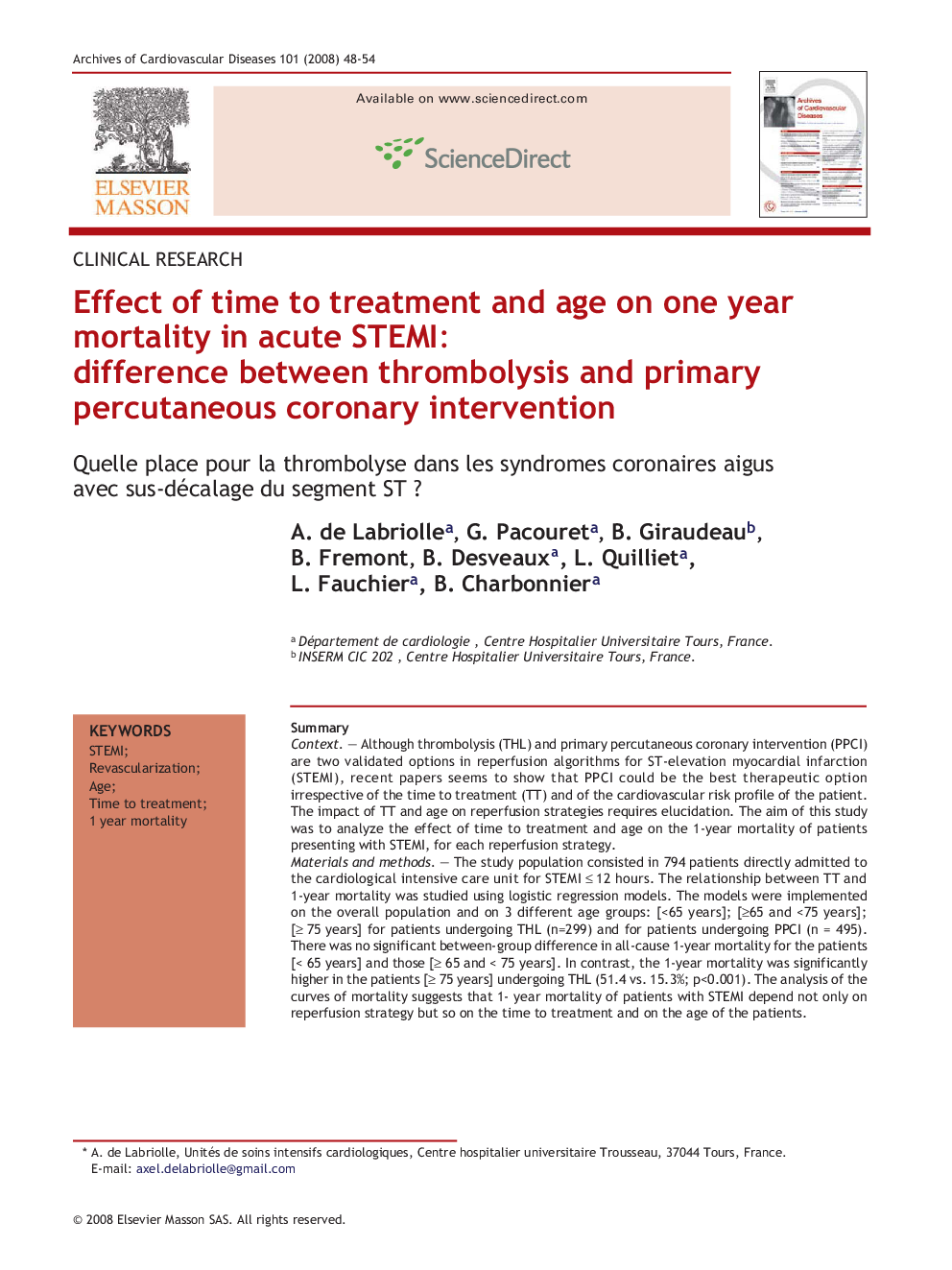| کد مقاله | کد نشریه | سال انتشار | مقاله انگلیسی | نسخه تمام متن |
|---|---|---|---|---|
| 2890067 | 1574419 | 2008 | 7 صفحه PDF | دانلود رایگان |

SummaryContextAlthough thrombolysis (THL) and primary percutaneous coronary intervention (PPCI) are two validated options in reperfusion algorithms for ST-elevation myocardial infarction (STEMI), recent papers seems to show that PPCI could be the best therapeutic option irrespective of the time to treatment (TT) and of the cardiovascular risk profile of the patient. The impact of TT and age on reperfusion strategies requires elucidation. The aim of this study was to analyze the effect of time to treatment and age on the 1-year mortality of patients presenting with STEMI, for each reperfusion strategy.Materials and methodsThe study population consisted in 794 patients directly admitted to the cardiological intensive care unit for STEMI ≤ 12 hours. The relationship between TT and 1-year mortality was studied using logistic regression models. The models were implemented on the overall population and on 3 different age groups: [<65 years]; [≥65 and <75 years]; [≥ 75 years] for patients undergoing THL (n = 299) and for patients undergoing PPCI (n = 495). There was no significant between-group difference in all-cause 1-year mortality for the patients [< 65 years] and those [≥ 65 and < 75 years]. In contrast, the 1-year mortality was significantly higher in the patients [≥ 75 years] undergoing THL (51.4 vs. 15.3%; p<0.001). The analysis of the curves of mortality suggests that 1- year mortality of patients with STEMI depend not only on reperfusion strategy but so on the time to treatment and on the age of the patients.ConclusionIn STEMI, on a 1-year mortality criteria, PPCI is not always upper than THL, particularly for patients < 65 years treated within the first two hours after symptoms onset. TT and age affects the results of the reperfusion strategies and must be still incorporated in the reperfusion algorithms of STEMI.
RésuméContexteBien que le délai de traitement soit le paramètre majeur des algorithmes de revascularisation dans les STEMI, son rôle pourrait dépendre du type de revascularisation et du profil de risque cardio vasculaire et plus particulièrement de l’âge des patients. Son impact dans les stratégies de revascularisation nécessite d’être clarifié. Le but de notre travail était d’analyser par classe d’âge, pour chaque stratégie de revascularisation, l’effet du délai de traitement sur la mortalité à un an des patients avec STEMI.Matériels et méthodesLa population de l’étude était constituée de 794 patients admis directement en USIC pour un STEMI ≤ 12 heures. La relation entre le délai de traitement et la mortalité à un an a été étudiée par des modèles de régression logistique. Ces modèles ont été réalisés dans la population générale et dans les 3 sous groupes d’âge différent: [< 65 ans] ; [≥ 65 et < 75 ans] ; [≥ 75 ans] pour les patients traités par thrombolyse (n = 299) et pour les patients traités par angioplastie primaire (n=495). La mortalité à un an toute cause n’était pas significativement différente entre le deux groupes de traitement pour les patients [< 65 ans] et pour ceux du groupe [≥ 65 et < 75 ans]. En revanche, la mortalité à un an était significativement plus importante dans le groupe de patients [≥ 75 ans] traités par thrombolyse (51,4 % versus 15,3 %; p <0.001). L’analyse des courbes de décès en fonction du délai de traitement montre que l’effet du délai de traitement sur la mortalité à un an dépends de la stratégie de revascularisation et de l’âge des patients.ConclusionNos résultats suggèrent que le délai de traitement affecte la mortalité de façon variable selon la stratégie de revascularisation utilisée et l’âge des patients traités. Ainsi, l’âge devrait faire partie des algorithmes en phase aigue de STEMI.
Journal: Archives of Cardiovascular Diseases - Volume 101, Issue 1, January 2008, Pages 48–54